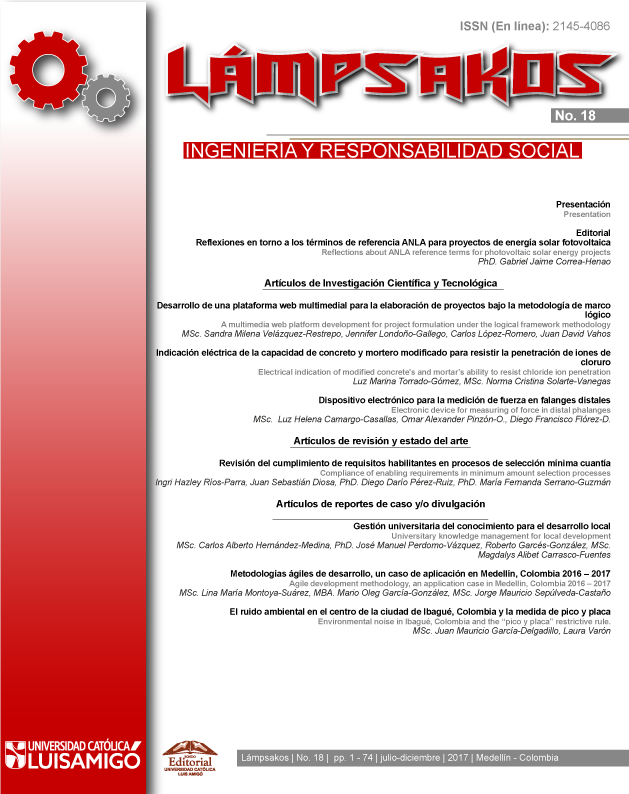Electrical Indication of Modified Concrete´s and Mortar´s Ability Resist Chloride Ion Penetration
DOI:
https://doi.org/10.21501/21454086.2358Palabras clave:
Concrete, Chloride ion, mortar, permeability.Resumen
This article describes the ability of concrete and mortar mixtures with different fly ash contents to resist chloride ion penetration 14 and 28 days after casting. The Rapid Chloride Permeability Test (RCPT) in accordance to the norm ASTM C1202 was used in order to obtain qualitative indications of the chloride ion penetrability depending on the electrical conductance of concrete respectively mortar samples. Furthermore, the Automatic Concrete Water Permeability Apparatus at Four Cells C430X from Matest was used to measure the water permeability 28 days after casting. Finally, the uniaxial compressive strength was measured 28 days after casting. The following conclusions can be made. The results of the Chloride Permeability Test (RCPT) did not show a clear correlation between the ash content, the a/c ratio and the Chloride Ion Penetrability. However, the chloride diffusion coefficient for the hormone and mortar at 28 days tends to increase with increasing a / c ratio and decreases with the age of hydration. As for permeability, an increase in the permeability was found at 28 days of age with an increasing ratio of a/c ratio.
Descargas
Referencias
J. Bijen, “Benefits of slag and fly ash,” Constr. Build. Mater., vol. 10, no. 5 SPEC. ISS., pp. 309–314, 1996. http://dx.doi.org/ 10.1016/0950-0618(95)00014-3
S. Antiohos, K. Maganari, and S. Tsimas, “Evaluation of blends of high and low calcium fly ashes for use as supplementary cementing materials,” Cem. Concr. Compos., vol. 27, no. 3, pp. 349–356, 2005. http://dx.doi.org/10.1016/j.cemconcomp.2004.05.001
S. Ahmad, “Reinforcement corrosion in concrete structures, its monitoring and service life prediction - A review,” Cem. Concr. Compos., vol. 25, no. 4–5 SPEC, pp. 459–471, 2003. http://dx.doi.org/ 10.1016/50958-9465(02)00086-0
T. R. Naik, “Chloride Ion Penetration Test, Carbonation Depth test and Salt Scaling Test,” Rilem, no. August, pp. 1–9, 2004. https://www4.uwm.edu/cbu/Papers/2004%20CBU%20Reports/REP-566.pdf
M. D. A. Thomas, “Optimizing the Use of Fly Ash in Concrete,” Portl. Cem. Assoc., p. 24, 2007. http://dx.doi.org/ 10.1016/0950-0618(95)00014-3
C.-C. Yang, Y.-S. Yang, and R. Huang, “The effect of aggregate volume ratio on the elastic modulus and compressive strength of lightweight concrete,” Journal of MarineScience and Technology. 1997. http://jmst.ntou.edu.tw/marine/5/31-38.pdf
Dhir, R.K. and Hewlett, P.C. Concrete Durability and Repair Technology. Proceedings of The International Seminar Held at The University of Dundee, Scotland, United Kingdom. https://books.google.com.co/books?hl=es&lr=&id=JueMm00Odn0C&oi=fnd&pg=PR1&dq=Dhir,+R.K.+and+Hewlett,+P.C.+Concrete+Durability+and+Repair+Technology.+Proceedings+of+The+International+Seminar+Held+at+The+University+of+Dundee,+Scotland,+United+Kingdom.&ots=ICr4HS70Jj&sig=Kbz-y5EcbFIwh3mLbV8tPwtsutI#v=onepage&q&f=false
K. S. Chia and M. H. Zhang, “Water permeability and chloride penetrability of high-strength lightweight aggregate concrete,” Cem. Concr. Res., vol. 32, no. 4, pp. 639–645, 2002. http://dx.doi.org/10.1016/S0008-8846(01)00738-4
Controls Group. Water permeability apparatus. http://www.controls-group.com/eng/concrete-testing-equipment/water-permeability-apparatus.php
C. C. T. Speci-, T. D. Cores, C. C. T. Speci-, B. Statements, and C. Testing, “Standard Test Method for Compressive Strength of Cylindrical Concrete Specimens ASTM C39M-37,” vol. 4, no. March, pp. 1–5, 2001. http://dx.doi.org /10.1520/C0039_C0039M-17B
E. C. Nacional, R. Calzada, and A. Azul, “Norma técnica guatemalteca ASTM C-109,” no. 502, 2013. https://conred.gob.gt/site/normas/NRD3/1_CEMENTO/2_NORMA_NTG_41003h4_ASTM_c109-c109m-11_b.pdf
R. Siddique, “Effect of fine aggregate replacement with Class F fly ash on the abrasion resistance of concrete. Cement and Concrete Research,” Cem. Concr. Res., vol. 33, no. 11, pp. 1877–1881, 2003. https://doi.org/10.1016/S0008-8846(02)01000-1
E. A. Kaur, “Strength and Duriabilty Properties of Concrete with Partial Replacement of Cement with Metakaolin and Marble Dust,” vol. 4, no. 7, pp. 1032–1035, 2015. http://www.kresttechnology.com/krest-academic-projects/krest-mtech-projects/Civil/Civil%20M.tech%20Projects%202017%20-2018/2.%20Concrete%20Projects/BASE%20PAPERS/26.%20Strength%20and%20durability%20study%20of%20metakaoline.pdf
B. S. Mohammed, K. M. A. Hossain, and W. L. Foo, “Rapid Chloride Permeability Test on Lightweight Concrete Made with Oil Palm Clinker,” vol. 1, no. 4, pp. 1863–1870, 1870. https://pdfs.semanticscholar.org/4cac/7e57f25b86722d0898a179c90e8450fd7e6a.pdf
and S. J. K. Y. Y. Kim, K. M. Lee, J.W. Bang, “Effect of W/C ratio on durability and porosity in cementmortar with constant cement amount,” Adv. inMaterials Sci. Eng., vol. 2014, 2014.http://dx.doi.org/10.1155/2014/273460.
Descargas
Archivos adicionales
Publicado
Cómo citar
Número
Sección
Licencia
De conformidad con las normas nacionales e internacionales sobre derechos de autor, las políticas de publicación de la Universidad Católica Luis Amigó y de la revista Lámpsakos (indexada con ISSN: 2145-4086), yo(nosotros), manifiesto(amos):
1. El deseo de participar como articulista(s) y someter a las normas editoriales establecidas por la revista (nombre la revista) el artículo titulado (nombre del artículo),
2. El compromiso de no retirar el artículo hasta no terminar el proceso de edición del número de la revista en curso.
3. Que el artículo es original e inédito y no ha sido postulado o presentado conjuntamente en otra(s) revista(s); por tanto, los derechos del artículo en cuestión no han sido cedidos con antelación y sobre ellos no pesa ningún gravamen ni limitación en su uso o utilización.
4. La inexistencia de conflicto de interés con institución o asociación comercial de cualquier índole.
5. Haber incorporado las citas y referencias de otros autores, tendientes a evitar el plagio. En consecuencia, afirmo que de ser publicado el artículo, no se violarán derechos de autor, de propiedad intelectual o de privacidad de terceros. Así mismo, de ser necesario, existe forma de evidenciar los permisos respectivos sobre derechos de autor originales para los aspectos o elementos extraídos de otros documentos como textos de más de 500 palabras, tablas, gráficas, entre otros. En caso de presentarse cualquier tipo de reclamación o acción por parte de un tercero en cuanto a los derechos de autor sobre el artículo, el(los) autor(es) asumirán toda la responsabilidad, y saldrán en defensa de los derechos aquí cedidos. Por tanto, para todos los efectos, la revista Lámpsakos de la Fundación Universitaria Luis Amigó actúa como un tercero de buena fe.
6. Que en el evento de publicarse el artículo, cedo(emos) a título gratuito y con carácter de exclusividad la integridad de los derechos patrimoniales así como los derechos de impresión, reimpresión y de reproducción por cualquier forma y medio, sin ninguna limitación en cuanto a territorio se refiere, en favor de la revista Lámpsakos de la Universidad Católica Luis Amigó.
7. Reconocer como coautores y/o colaboradores, a todos quienes participaron en ese rol y no se ha omitido a ninguno.








